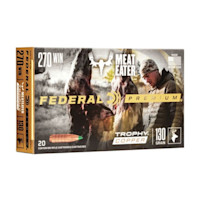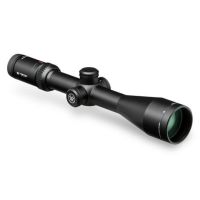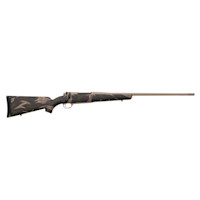
In 1983, Colonel Jeff Cooper hosted a conference he believed would modernize rifle design and launch the “new wave” long gun of the future. The famous instructor, hunter, and author described this new style of firearm in a manifesto of sorts published in the gun magazine, American Rifleman.
The “scout rifle,” as he called it, was designed for maximum practical efficacy. It would be short, light, and quick to operate; powerful enough to take game of up to 440 pounds; and accurate enough put shots on target at most hunting distances.
According to scout rifle expert Richard Mann, Cooper imagined scout rifles as the ultimate do-it-all rifle, a “friendly and handy” companion for long excursions alone in the wilderness. Mann is the author of “The Scout Rifle Study,” and has hunted with scout rifles for many years, including on three successful African safaris.
“Cooper wanted a rifle that could be used by someone operating remotely and alone to put food on the table and defend himself,” Mann told MeatEater. “That’s what scouts do. They don’t go out and fight. They observe and collect information, report back, and work alone for weeks at a time. That’s what he designed the rifle for, and if you look at it in that context, it’s hard to find a better option.”
What Is a Scout Rifle? Cooper put forward a specific set of criteria that would come to define his scout rifle concept: Scout rifles should be no longer than 39.4 inches, weigh no more than 6.6 pounds, and feature a forward-mounted fixed-power scope with a magnification of no greater than 3x. Iron sights were to be affixed in case of scope malfunction, and the trigger was to provide a “crisp 3-lb. release.”
Scout rifles were to be chambered in .308 Winchester (though Cooper allowed for a few additional chamberings) and should use a 19-inch barrel along with a two-lug, 90-degree bolt. The colonel also recommended the use of synthetic stocks to make weight.
Since Cooper invented these criteria more or less on his own, they may seem arbitrary and even unnecessary. Facebook groups and internet forums abound with rationales for why some of Cooper’s scout rifle standards should be thrown out, whether because modern optics and ammunition have made them obsolete, or because no rifle manufacturers produce affordable rifles with these characteristics.
Mann pointed out, however, that the colonel had his reasons for each criterion—and they make a real impact. “If you’ve handled a rifle that meets Cooper’s criteria, you’ll feel a tremendous amount of difference. There’s a major difference in handiness and friendliness,” Mann said.
Cooper loved both the 1894 Winchester lever-action chambered in .30-30 Win. and the 6.5 Mannlicher-Schoenauer Carbine. Both rifles are lightweight, easy to handle, and a pleasure to shoot, but Cooper wanted something with a little more juice. As a child of World War II, he preferred the .30-06 Springfield, but he knew the large action wouldn’t be able to accommodate his weight specifications.
So, according to Mann, he turned to the Remington Model 600 in .308 Win. The short barreled bolt-action came in at 6.5 pounds, and Cooper hoped other manufacturers would be able to make rifles with similar or even reduced weight.
The scout’s most unique feature is the forward-mounted scope, which Cooper preferred so the rifle could also be fitted with iron sights. Mann noted that variable-power optics weren’t reliably rugged in Cooper’s day, and he wanted a backup sighting system in case of scope failure. Low, fixed-power optics were more durable and allowed the user to aim with both eyes open, which, Cooper said, “is the fastest sighting arrangement available to the rifleman.”
Cooper admits that the “new-wave rifle” is “neither more powerful nor intrinsically more accurate than the rifles of the past,” but it is “much, much handier—shorter, lighter and quicker to operate.”
Does Scout Rifle = Deer Rifle? The advantages of a light, quick-shooting deer rifle are obvious, and the scout concept is especially attractive to hunters in the eastern and southern parts of the United States.
“I think it is a superb deer rifle,” said Steve Clifford. “This is especially true if you get out of a stand or blind. It is light, handy, accurate, and powerful. If you train with it, first round hits at reasonable ranges are extremely fast. I can't think of a better choice in Virginia Piedmont farmland.”
Clifford is a scout rifle afficionado and member of the Facebook group Jeff Cooper’s Scout. (It’s worth a follow if you’re interested in scout rifles!) Clifford spoke to MeatEater while attending a scout rifle class at the NRA’s Whittington Center in honor of Cooper’s 101st birthday.
While snap shots are rarely a good idea, especially on public land, there’s a clear advantage to getting on target quickly and keeping both eyes open while shooting. That situational awareness allows hunters to see if another buck is emerging from the tree line. New hunters shouldn’t have any trouble finding the reticle inside a low-powered scout scope.
“Once you leave the deer stand and start still hunting and shooting from field positions, it's hard to beat!” said Larry Dyer, another longtime scout rifle hunter. His and Clifford’s praise was echoed by a number of scout rifle hunters we spoke with.
There are, of course, disadvantages to the scout design, and they mainly involve the scope. Scout scopes feature long eye relief and (often) small-diameter objective lenses. Only a few of the high-end manufacturers have invested heavily in the design. These drawbacks mean hunters often can’t see as well at dawn and dusk.
“The downside is the optic. Most deer hunters cherish the first 30 minutes and last 30 minutes of the day, and you’d hate for a [big deer] to walk out and not be able to find him in the riflescope,” Mann said. “That doesn’t mean it wouldn’t be a good deer rifle. I’ve taken deer with it. You just hope that, when you first see one, that it’s visible.”
Evan Williams saved for two years before purchasing his first scout rifle, and he’s used it to take both pigs and deer. But he pointed out that the 2x scout scopes can hinder deer identification. On one California blacktail hunt, Williams nearly lost a buck because he couldn’t identify it in his scope.
“Using my binoculars, I scanned [the herd] and saw the better buck was the second one from the right. They were all up and feeding, and as I transitioned from binoculars to scope, they all moved and switched places. Not knowing which one was the buck, I had to return to my binoculars to see that, now, the buck was three from left,” he explained.
He eventually hit his intended target, but after missing a shot on a buck during his next trip, he swapped his 2x for a 3-9x.
A Challenge Worth Accepting If modern-day scout rifle owners fudge on any of Cooper’s requirements, it’s likely to be on the scope. Several (though not many) scope manufacturers offer variable-power scout scopes, and Mann told us that all his scout rifles are fitted with low-power variable optics.
Cooper’s weight requirements are also extremely difficult to maintain. Not many manufacturers offer rifles with forward rails for scope mounting and iron sights, and none of them offer a rifle that makes the 6.6-pound weight cutoff.
Steyr’s Scout rifle is the closest, weighing in at exactly 6.6 pounds and features the integrated bipod Cooper preferred. But adding a scope and sling pushes the weight beyond Cooper’s limit, and the rifle doesn’t come with iron sights. Also, its $1,749 price tag isn’t what most hunters would consider affordable.
Ruger, Savage, and Mossberg all make rifles in the scout configuration, but Mann told us the only way to meet all of Cooper’s criteria is to go with a custom-built gun. Some hunters have fitted scout scope rails onto ultralight rifles like the Weatherby Backcountry Ti, while others have built totally custom firearms. In any case, it’s going to cost a pretty penny.
At this point, you might be scratching your head at this article’s title. A potentially expensive rifle that comes with significant limitations in lowlight conditions doesn’t sound like the ideal deer gun. Admittedly, there are better options, and many of the scout rifle fans we spoke with admitted as much. Mann (who literally wrote the book on scout rifles) acknowledge that the platform usually doesn’t outperform more traditional options.
But neither do muzzleloaders, bows, or shotguns. Scout rifles have maintained a small but committed following not because they’re the perfect rifle for any one application, but because they present a unique challenge and come with a history, tradition, and philosophy.
“There’s a lot of romanticism attached to it. That’s what drew me into it originally,” Mann said. “Cooper had written about it so much, and I had read about it a lot.” Other scout rifle fans also mentioned being drawn to scout rifles through Cooper’s work.
“I read Jeff Cooper’s books and became persuaded by them,” Williams said. “Jeff Cooper’s article convinced me that the scout rifle concept was an all-purpose, do-anything rifle. If a man could only have one rifle it should be a scout.”
The scout has certain inherent advantages, but its limitations are also attractive because they give hunters a way to test their skills and challenge themselves.
“I have four or five scout rifles. I’ve had a lot of fun using them in Africa, but I don’t think that, from a hunting standpoint, they’re better than a traditional gun with a low-power variable scope,” Mann said. “But if you can shoot, and if you’ve got decent eyes and are a good hunter, that difference will probably never matter to you.”
The inverse, of course, is also true: If you can take game with a scout rifle, you probably know what you’re doing in the deer woods.
Scout rifles are a challenge to build and, in some cases, a challenge to hunt with. But if you’re looking for something a little different that tests your limits and gives you access to a passionate and friendly community, your next deer rifle should be a scout rifle.





